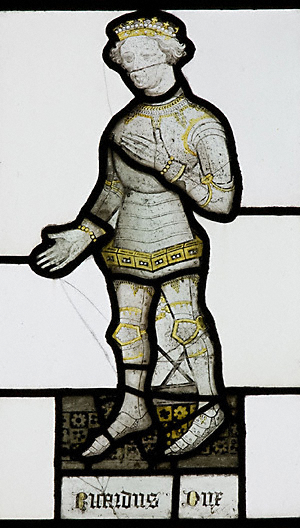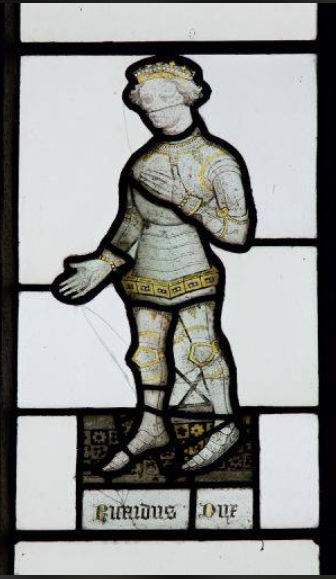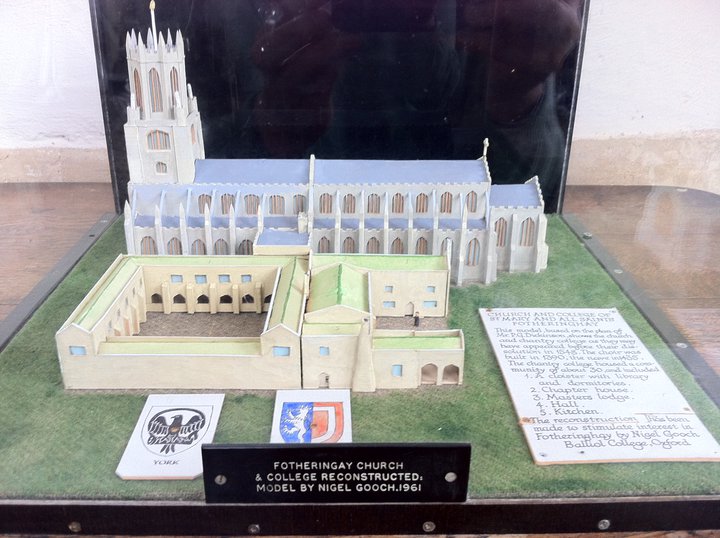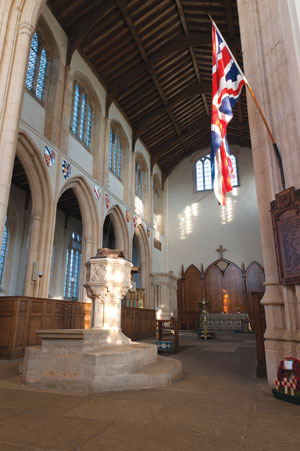545 years ago between July 21st and July 30th 1476 in an elaborate set of ceremonies the remains of Richard Duke of York, father of King Edward IV and King Richard III, and of his second son, Edmund Earl of Rutland, were moved from their first burial place at Pontefract to the family mausoleum of the House of York, the Collegiate Church at Fotheringhay in Northamptonshire.

Image: Wakefield Historical Society
The Duke and his son had been killed at the battle of Wakefield on December 30th 1460 and their heads together with those of other Yorkists had been displayed on Micklegate Bar in York. Following the Yorkist victory at the battle of Towton on March 29th 1461 the heads were removed and interred with the bodies at Pontefract.
Richard Duke of York
Stained glass at Trinity College Cambridge
Together with the Cirencester head shown above these are the only two serious contemporary representations of the Duke. The Shrewsbury MS one appears too general beyond giving him fair hair. Apart from a different hair style the two glass portraits appear to be consistent with each other.
Image: History of Parliament.wordpress
Buried alongside York and his son were two other victims of the battle at Wakefield or its aftermath. These were York’s brother-in-law the Earl of Salisbury and one of his sons, Sir Thomas Neville. Their remains were exhumed and removed to Bisham Priory in Berkshire in January 1462-3.
The 1476 reburial - perhaps delayed by the completion of the church at Fotheringhay which had been largely paid for by the Duke - is recorded in a series of Herald’s accounts and other records, all of which are edited together with an introduction in an invaluable article in The Ricardian. This is, or was, available as a separate booklet. It is the work of P.W.Hammond, Anne F. Sutton and Livia Visser-Fuchs, and is a detailed and fascinating record of Yorkist ceremonial blending the rituals of Church and Crown and can be accessed at 03
One slight amendment I would venture to that account is that I do not think these victims from the battle of Wakefield were buried in the
Cluniac priory of St John but rather the Dominican house of St Richard in Pontefract.
St John’s was very much under Lancastrian patronage, although in 1483 it did provide a burial place for Earl Rivers, Lord Richard Grey and Sir Thomas Vaughan after their execution at the adjacent castle. That however was after a generation of Yorkist rule.
Secondly friaries of the Austin, Dominican and Franciscan orders often provided burial for what one might term ‘celebrity corpses’, victims of the battlefield or the scaffold, in this period.
However the key piece of evidence is a 1534 Herald’s account of burials in the Dominican church in Pontefract which records the heart burials there of York, Rutland, Salisbury and Neville. This would incidentally suggest that their bodies may have been embalmed in 1460. These were not recovered during excavations on the site in 1963 and in 2011 and 2012, and they presumably still lie under Pontefract General Infirmary which occupies the site of the medieval friary,
Situated by one of the two routes to the south from the town it is not too difficult to envisage the mourners assembling there and the cortège departing towards the overnight stops and requiems at Doncaster, Blyth, Tucford, Newark, Grantham, Stamford and eventually to the burial at Fotheringhay.
One of the principal residences of the York family Fotheringhay castle stood with the collegiate foundation alongside, the church refounded and then extended in 1411 by the previous, second Duke who died at Agincourt in 1415 as his intended place of burial.

A reconstruction of Fotheringhay Castle
Image: historyofengland.co.uk
Thrre are illustrated descriptions of the church at Fotheringhay from Wikipedia at Church of St Mary and All Saints, Fotheringhay,
from English Church Architecture, which includes a plan, at Fotheringhay, from English Monarchs at Fotheringhay - The Mausoleum of the House of York and at Visit to Fotheringhay – Part 2, A History of the Church of St Mary and All Saints
Even in its truncated form it is still a hauntingly beautiful building, and still possesses its fifteenth century pulpit with Yorkist badges.
A reconstruction model of the Church and College at Fotheringhay
Only the tower and the five bays of the nave survive
Image: Wikimedia
The remaining portion of Fotheringhay Church
Image: Wikipedia
The Dukes of York and the Earl of Rutland were reinterred in 1573 in the monuments to the north and south of the altar
Images: the moment magazine.com
In 1566 Queen Elizabeth I visited Fotheringhay and was shocked to find her relatives tombs in decay in the ruined eastern portion of the church. She ordered the removal of their remains into what was still serving as the parish church. This was completed in 1573.

The Elizabethan tomb of the Duke of York
Image: warmingtonbenefice.org.uk






No comments:
Post a Comment